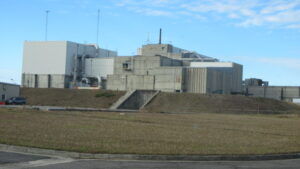
The Barnwell reprocessing plant in South Carolina, adjacent to the Savannah River Site, thankfully never operated, thus sparing South Carolina huge volumes of highly radioactive nuclear waste and separated weapon-usable plutonium. Photos by SRS Watch, 2019
Reprocessing of spent nuclear fuel from commercial nuclear power reactors is a dirty and dangerous process, fraught with proliferation concerns. This proposal for a US reprocessing plant is laughable and is really designed to harvest money from the US taxpayers, via a Department of Energy which is promoting reprocessing. Reprocessing makes no sense from economic, proliferation or waste-management perspectives and this scheme is destined to fail. But that doesn’t mean DOE or Congress will throw money at it, which is the real goal at play.
“Used Nuclear Fuel Recycling Agreement Signed by Orano and SHINE Technologies”
BETHESDA, Md., February 29, 2024 – Orano and SHINE Technologies signed a Memorandum of Understanding (MOU) this week to cooperate in the development of a U.S. pilot plant with commercial-scale technology for recycling used nuclear fuel from light water reactors.
The recovered nuclear material can be made into new fuel for advanced and existing reactor designs along with using certain critical isotopes for medical and industrial purposes.
“This MOU aligns two innovative companies in the single pursuit of recycling 100 metric tons a year of used nuclear fuel into a valuable resource,” said Nicolas Maes, CEO of Orano. “For this initiative with SHINE, we bring more than 55 years of experience transporting and recycling used nuclear fuel in France and managing used fuel in the U.S.”
“Our goal is to stand up an operational pilot facility by the early 2030s. While this is challenging, our track record with the Chrysalis facility shows that we know how to navigate the complex design, regulatory, and build aspects of 10 CFR part 50 nuclear facilities and do so cost-effectively. The lessons learned in the execution of that project are directly applicable to waste recycling, and uniquely position us for timely delivery on this important national priority,” said Greg Piefer, Founder and CEO of SHINE Technologies. “This agreement for closing the nuclear fuel cycle launches our company’s planned Phase 3 business along our path to ultimately achieving commercialized fusion energy.”
Site selection for the pilot facility in the U.S. is expected by the end of this year. The pilot plant concept will validate commercial-scale aqueous recycling with integrated nonproliferation measures. The system is based on SHINE’s proven critical separation technology and Orano’s methods in operation at its La Hague facility in France, where more than 40,000 tons of used nuclear fuel have been reprocessed.
“It is time for the U.S. to seriously consider recycling used nuclear fuel,” said Jean-Luc Palayer, CEO of Orano USA. “Working together, SHINE and Orano will extract the valuable material for use in critical industrial applications and in creating new nuclear fuels for existing reactors and future advanced reactors.”
This initial agreement is seen as a first step in a broader coalition of companies focused on developing a national used nuclear fuel recycling industry. Two of the biggest challenges for increasing carbon-free nuclear energy are waste disposal and cost. This coalition aims to play a leading role in providing a cost-effective solution to nuclear energy growth by recycling and reusing used nuclear fuel, and by transforming long-lived radioactive waste into shorter-lived or stable materials.
Used nuclear fuel still contains more than 90% of its energy capacity when it is removed from the reactor. Globally, a select few countries choose to recycle used fuel in what is termed “a closed fuel cycle.” Though the United States originally developed the technology and began recycling used nuclear fuel in 1963, the program ceased operation in 1972. Since then, the U.S. has an open fuel cycle with used nuclear fuel stored in interim facilities at operating or closed nuclear reactor sites around the country for eventual disposal as waste in a future permanent geologic repository.
Recycling used nuclear fuel into useful products will significantly reduce the mass, volume, and toxicity of the remaining nuclear material for permanent disposal.
By helping to solve the used fuel problem, this coalition’s new recycling program will help fission nuclear energy grow and deliver carbon-free energy faster.